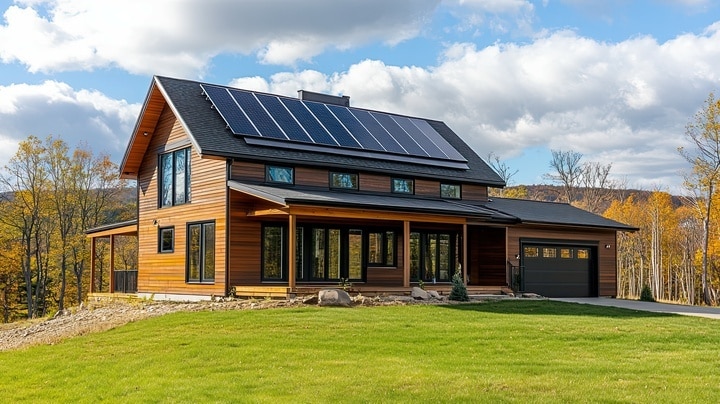Solar Photovoltaics

Solar Photovoltaics Explained: Definition, Uses and More
A photovoltaic system and a solar energy system are synonyms. Photovoltaic derives from two root words. First, “photo” which comes from the Greek word for “light.” Secondly, “voltaic” which refers to Allessandro Volta, the Italian physicist who invented the electric battery. Photovoltaic literally means “light-electric,” referring to the process of converting light into electricity. This term is used to describe the technology and systems, such as solar panels, that achieve this conversion.
Components of a Photovoltaic System
A photovoltaic system includes several key components:
- Solar Cells: These are the basic units of PV technology made from semiconductor materials like silicon, where the magic of sunlight-to-electricity conversion happens.
- Modules and Panels: Groups of solar cells form modules, which are further assembled into panels for practical use.
- Inverters / Microinverters: Devices that transform direct current (DC) produced by solar cells into alternating current (AC) suitable for household appliances and grid distribution.
- Balance of System (BOS): This includes wiring, mounts, and optional storage systems like batteries to optimize energy use.
- Battery Storage (Optional): Batteries store excess energy generated for later use at night, periods of high energy use or during power outages, enhancing energy reliability and independence.
- Monitoring System: Tracks system performance and energy production.
- Meter: Measures the excess electricity you put back into the grid and the electricity consumed from the grid.
- Combiner Box: This box aggregates power from several PV module strings, simplifying system management and protection
- Solar AC Disconnect: A safety device that allows you to manually disconnect the alternating current (AC) power from your solar system to the electrical grid.
- Main Service Panel: This is the central switchboard for all the electricity in your home. It houses the solar breakers, which can shut off power to your solar system
- Backup Panel (aka Critical Loads Panel or Subpanel): A separate electrical panel that powers essential circuits during a grid outage.
- Utility Meter: Measures electricity sent to and pulled from the grid
Types of Photovoltaic Systems
Solar PV systems come in various forms to suit different needs:
- Grid-Tied Systems: A grid-tied photovoltaic system is a solar energy setup connected to the utility grid, allowing users to draw electricity from the grid when solar production is insufficient and feed excess energy back to the grid. These systems typically rely on the grid for backup and do not require battery storage, making them cost-effective and popular for residential and commercial use. Grid-tied PV Systems can allow homeowners or businesses to sell excess energy back to the utility through net metering.
- Off-Grid Systems: An off-grid photovoltaic system operates independently of the utility grid, relying solely on solar panels and battery storage to provide electricity. Designed for remote or self-sufficient applications, these systems require sufficient storage capacity to supply power during nighttime or cloudy periods.
- Hybrid PV System (Grid-Tied with Battery Backup): A hybrid photovoltaic system combines solar panels with battery storage and is also connected to the utility grid, offering flexibility to draw power from multiple sources. This setup allows users to store excess solar energy for later use while accessing the grid when needed, providing greater energy reliability and independence. This type of PV system is ideal for those living in places with high electricity prices and/or frequent outages.
Benefits of Photovoltaics
Cost Savings: Can lower electricity bills by harnessing abundant sunlight and converting it into electricity. The more energy a system produces, the more it lowers energy costs which add up over time. Eventually, the amount of energy costs saved will exceed the initial cost of the PV system — meaning it has paid itself off. When factoring in incentives — like tax credits or net metering — the payback period for a PV system shortens and improves return on investment.
Environmental Impact: Photovoltaic systems help combat climate change by significantly reducing greenhouse gas emissions and decreasing reliance on finite fossil fuels. Solar panels work by harnessing energy from the sun — an abundant and renewable resource — and converting it into clean, emission-free electricity. Unlike fossil fuel-based energy, solar power generation produces no air or water pollution, making solar a sustainable and environmentally friendly alternative for meeting energy needs.
Energy Independence: Photovoltaic systems with battery storage provide energy independence by shielding consumers from fluctuating electricity prices, utility grid outages and fossil fuels. Solar panels generate renewable electricity during the day, while batteries store excess energy for use at night or during outages, ensuring a consistent power supply. This setup offers financial stability and increased resilience. By adopting PV systems with storage, users gain control over their energy usage while contributing to a sustainable future.
Scalability: Photovoltaic systems offer exceptional scalability and versatility, making them ideal for residential, commercial and industrial applications. They can be tailored to meet various energy demands, from small rooftop installations for homes to expansive solar farms powering industrial facilities. Photovoltaic systems are modular, allowing users to expand capacity as needed, ensuring flexibility for future growth. Their adaptability extends to diverse settings, including urban rooftops, rural areas and even remote locations. This versatility allows businesses and homeowners to achieve energy goals regardless of scale or geography. PV systems provide a customizable solution for a wide range of energy needs.
Challenges Facing Photovoltaics
>Weather Dependence: Solar energy production is directly tied to sunlight availability. On cloudy days, during storms or at night, photovoltaic systems produce little to no electricity. This variability can make solar energy less reliable without complementary systems like energy storage or grid backup, particularly in regions with inconsistent sunlight.
>Storage Costs: To address the issue of inconsistent energy generation, batteries are often used to store excess solar power for nighttime or low-sunlight periods. However, the cost of advanced battery systems remains high, increasing the overall investment required for a solar photovoltaic system. While prices for storage are gradually declining, affordability is still a barrier for many homeowners and businesses seeking energy independence.
>Space Requirements: Solar photovoltaic installations require a significant surface area to generate substantial amounts of electricity. Large-scale systems, such as those used in commercial or industrial settings, often need extensive land or roof space, which may not always be available or feasible in densely populated urban areas. For residential systems, limited roof space can restrict the amount of energy generated, potentially leaving users reliant on supplemental grid power.
Despite these challenges, ongoing advancements in technology and government incentives are gradually addressing these barriers. Improved energy storage solutions, innovative panel designs, and creative use of available spaces—such as vertical installations or community solar projects—are helping to overcome limitations. Solar PV continues to hold significant promise as a sustainable energy solution, even as efforts to address its hurdles progress.
The Future of Photovoltaics
Conclusion
Photovoltaics has the potential to reshape our energy landscape, making a sustainable future within reach. By adopting home solar solutions, individuals and businesses can take meaningful steps toward a greener planet—because the power to transform our world is in our hands and it starts with the sun.

